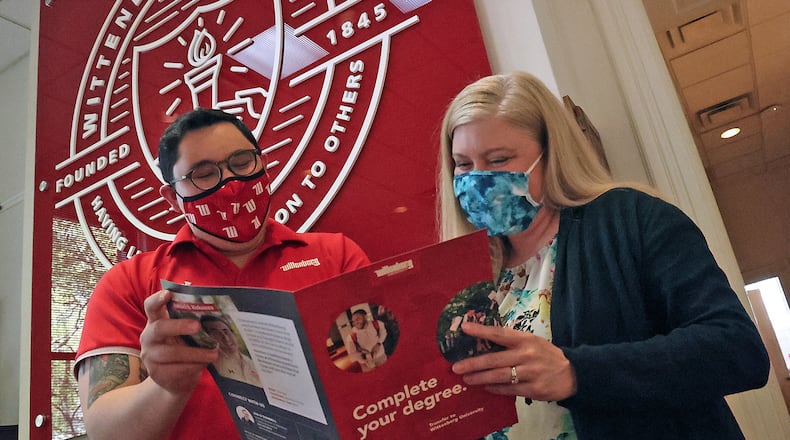Wittenberg University saw a decline of 155 students from 1,502 in spring 2020 to 1,347 in spring 2021, according to the university’s Office of Institutional Research, amounting to a 10.3% drop.
Clark State College officials saw a decline of 443 students between 2020 and 2021. Their spring 2020 enrollment was 6,038 and spring 2021 enrollment was 5,595, showing a 7.3% drop.
The Clearinghouse data showed that undergraduate students accounted for the entire decline with a 4.9% drop, or 727,000 students, but graduate enrollment increased by 4.6%, or 124,000 students.
Community colleges remain the hardest hit, declining 9.5%, or 476,000 students, and over 65% of the total undergraduate enrollment declines happened in the community college sector.
“The final estimates for spring enrollment confirm the pandemic’s severe impact on students and colleges this year,” said Doug Shapiro, Executive Director, National Student Clearinghouse Research Center. “How long that impact lasts will depend on how many of the missing students, particularly at community colleges, will be able to make their way back to school for the coming fall.”
Data also showed that this is the steepest student headcount decline in a decade - since spring 2011 - which is the first year the center published enrollment data. The second steepest enrollment decline was recorded in fall 2020.
Although the Clearinghouse data shows this decline as the steepest in the last decade, Wittenberg’s enrollment since that year increased by 498 students. Their 2011 enrollment was 1,845.
Officials said enrollment challenges “are not unique” to the university, but say declines continue to be due to COVID-19.
“Nationally, undergraduate, degree-seeking enrollment has declined for 11 straight years. Recent data on spring semester enrollment shows that the trend accelerated as a result of the COVID-19 pandemic,” said Carola Thorson, Vice President for Enrollment Management.
“It affects us in that more students will not be able to experience our intentional, personalized education, which we know changes lives. Certainly, any dips in enrollment also affect every college’s budget, but at Wittenberg we recognized early that this could happen in light of the pandemic and adjusted our budget projections accordingly,” Thorson added.
Thorson said to help enrollment they always welcome students at any stage and will continue to do so.
Clark State only showed a decline since 2011 of 51 students. Their 2011 enrollment was 5,544.
Officials at the college also say the decline is a result of COVID-19.
“The national trend for college enrollment was on a slight decline prior to the COVID-19 pandemic and once the health restrictions were put in place, it further impacted the way individuals viewed attending institutions of higher education,” said Ron Gordon, Dean of Enrollment Services.
“Online course offerings were the only option in many cases and what was emphasized during the pandemic is many students, especially those attending community colleges, were faced with technology barriers precluding them from taking courses,” Gordon added.
Although enrollment has been on a decline, Gordon said the college is “seeing a bounce back” as “summer statistics are positive.”
“Clark State continues to explore efforts that are designed to increase recruitment, retention and completion of our students,” he said.
The college is also holding fall registration events on Wednesdays in July and the first Wednesday in August to provide students a “one-stop opportunity” to prepare for fall semester.
The Clearinghouse data showed enrollment among male students continued to decline by 5.5%, or 400,000 students, which is more than female students, who dropped by 2%, or 203,000 students.
Wittenberg’s data shows both their male and female student enrollment from 2020 to 2021 declined by 67 students and 88 students, respectively. The male student enrollment decreased from 683 in 2020 to 616 in 2021 and its female student enrollment dropped from 819 in 2020 to 731 in 2021.
At Clark State, their male and female student enrollment also declined from 2020 to 2021, data shows. The male student enrollment decreased by 199 students, from 2,080 in 2020 to 1,881 in 2021. The female student enrollment dropped by 244 students from 3,958 in 2020 to 3,714 in 2021.
Overall, enrollment in Ohio decreased by 20,446 students from 547,336 in spring 2020 to 526,890 in spring 2021, data shows. At public four-year institutions, enrollment dropped from 284,778 in spring 2020 to 278,129 in spring 2021 - a decline of 6,649 students. At public two-year institutions, enrollment dropped from 142,035 in spring 2020 to 131,890 in spring 2021 - a decline of 10,145 students.
The data showed that business, healthcare and liberal arts were the most common undergraduate majors for both four-year and two-year college students. Based on year-over-year percent change, computer science and psychology had the highest enrollment growth at four-year colleges by 3% and 4.8%, respectively.
At Wittenberg, the most common majors are education, business, biology, exercise science and psychology. Their least common majors are world language, religion, theatre and dance. Over the last year, enrollment dropped by 11 students in education, decreased by nine students in business, decreased by 21 students in biology, increased by two students in exercise science and stayed the same in psychology.
Clark State’s most common majors are registered nursing, general transfer - associate of science, practical nursing certificate, general transfer - associate of arts, and management. From 2020 to 2021, enrollment dropped by 19 students in registered nursing, decreased by 86 students in general transfer - associate of science, decreased by one student in practical nursing certificate, dropped by seven students in general transfer - associate of arts, and decreased by 18 students in management.
Facts & Figures
4.9: Percentage drop in undergraduate spring student enrollment between 2020 and 2021
10.3: Overall percentage decrease in spring student enrollment at Wittenberg University
9.5: Percentage drop in community college enrollment
7.3: Percentage drop at Clark State Community College spring 2020 vs 2021 enrollment
About the Author


